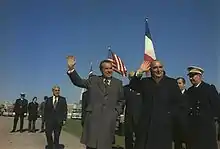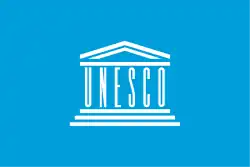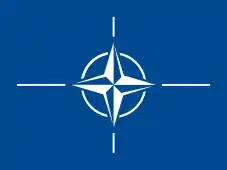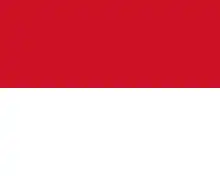Georges Pompidou | |
|---|---|
.jpg.webp) Pompidou in 1969 | |
| 19th President of France | |
| In office 20 June 1969 – 2 April 1974 | |
| Prime Minister | Jacques Chaban-Delmas Pierre Messmer |
| Preceded by | Charles de Gaulle |
| Succeeded by | Valéry Giscard d'Estaing |
| Prime Minister of France | |
| In office 14 April 1962 – 10 July 1968 | |
| President | Charles de Gaulle |
| Preceded by | Michel Debré |
| Succeeded by | Maurice Couve de Murville |
| Member of the Constitutional Council | |
| In office 5 March 1959 – 14 April 1962 | |
| Appointed by | Charles de Gaulle |
| Preceded by | Position established |
| Succeeded by | Bernard Chenot |
| Additional positions | |
| Personal details | |
| Born | Georges Jean Raymond Pompidou 5 July 1911 Montboudif, France |
| Died | 2 April 1974 (aged 62) Paris, France |
| Resting place | Orvilliers Cimetiere Orvilliers, France |
| Political party | Union of Democrats for the Republic (1968–1974) |
| Other political affiliations | Union for the New Republic (Before 1968) |
| Spouse | |
| Children | Alain |
| Alma mater | École Normale Supérieure Sciences Po |
| Signature | |
| Military service | |
| Allegiance | France |
| Branch/service | French Army |
| Years of service | 1940 |
| Rank | Lieutenant |
| Unit | 141st Alpine Infantry Regiment |
| Battles/wars | Second World War |
| Awards | Croix de Guerre |
Georges Jean Raymond Pompidou (/ˈpɒmpɪduː/ POMP-id-oo, French: [ʒɔʁʒ pɔ̃pidu] ⓘ; 5 July 1911 – 2 April 1974) was a French politician who served as President of France from 1969 to his death in 1974. He was earlier the longest-ever Prime Minister of France, under President Charles de Gaulle, from 1962 to 1968.
In the context of the strong growth of the last years of the Trente Glorieuses, Pompidou continued De Gaulle's policy of modernisation, which was symbolised by the presidential use of the Concorde, the creation of large industrial groups and the launch of the high-speed train project (TGV). The government invested heavily in the automobile, agribusiness, steel, telecommunications, nuclear and aerospace sectors and also created the minimum wage (SMIC) and the Ministry of the Environment.
His foreign policy was pragmatic although in keeping with the Gaullist principle of French independence. It was marked by a warming of relations with Richard Nixon's United States, close relations with Leonid Brezhnev's Soviet Union, the launch of the snake in the tunnel and the relaunching of European construction by facilitating the United Kingdom's entry to the EEC in contrast to de Gaulle's opposition.
Pompidou died in office in 1974 of Waldenström's disease, a rare form of blood cancer. His presidency is generally held in high esteem by French political commentators.
A man of letters, he belongs to a long line of French statesmen with an excellent writing style. His "Anthology of French Poetry" is still a reference and is part of the school curriculum. He was passionate about contemporary art, and his name remains known worldwide for the Centre national d'art et de culture Georges-Pompidou, which he initiated and was inaugurated in 1977; it subsequently spread the name with its branches in Metz (France), Malaga (Spain), Brussels (Belgium) and Shanghai (China). A Georges Pompidou Museum is also dedicated to him in his hometown.
Early life
The family of Georges Pompidou was of very modest origins. He was the grandson of farmers of modest means in Cantal on both his father's and his mother's side. His parents were teachers. His case is thus often cited as a typical example of social mobility in the Third Republic because of public schooling.[1]
Georges Jean Raymond Pompidou was born on 5 July 1911[2] in the commune of Montboudif, in the department of Cantal, in south-central France.[3] After his hypokhâgne at Lycée Pierre-de-Fermat[4] and his khâgne at Lycée Louis-le-Grand, where he befriended the future Senegalese poet and statesman Léopold Sédar Senghor, Pompidou attended the École Normale Supérieure from which he graduated with a degree of agrégation in literature.
He first taught literature at the lycée Henri IV in Paris until he was hired in 1953 by Guy de Rothschild to work at Rothschild. In 1956, he was appointed the bank's general manager, a position that he held until 1962. Later, he was hired by Charles de Gaulle to manage the Anne de Gaulle Foundation for Down syndrome (de Gaulle's youngest daughter, Anne, had Down syndrome).
Prime Minister
Jacques Chirac served as an aide to Prime Minister Pompidou and recalled:
The man gave the appearance of being secretive, wily, a little cunning—which he was, to a degree. However, it was primarily his intelligence, culture, and competence that conferred indisputable authority on him and commanded respect.... I remember his untamed eyebrows, his penetrating, very kindly gaze, his perceptive smile, full of humour and mischievousness, his voice with its wonderful low, warm, gravelly tone, and a figure that was both powerful and elegant. Naturally reserved, little given to emotional outbursts, Pompidou did not forge very close ties with his colleagues.[5]

He served as prime minister of France under de Gaulle after Michel Debré resigned, from 14 April 1962 to 10 July 1968, and to this day is the longest serving French prime minister under the Fifth Republic. His nomination was controversial because he was not a member of the National Assembly. In October 1962, he was defeated in a vote of no-confidence, but de Gaulle dissolved the National Assembly. The Gaullists won the legislative election and Pompidou was reappointed as Prime Minister. In 1964, he was faced with a miners' strike. He led the 1967 legislative campaign of the Union of Democrats for the Fifth Republic to a narrow victory. Pompidou was widely regarded as being responsible for the peaceful resolution of the student uprising of May 1968. His strategy was to break the coalition of students and workers by negotiating with the trade-unions and employers (Grenelle conference).
However, during the events of May 1968, disagreements arose between Pompidou and de Gaulle. Pompidou did not understand why the President did not inform him of his departure to Baden-Baden on 29 May. Their relationship, until then very good, would be strained from then on. Pompidou led and won the 1968 legislative campaign, overseeing a tremendous victory of the Gaullist Party. He then resigned. Nevertheless, in part due to his actions during the May 1968 crisis, he appeared as the natural successor to de Gaulle. Pompidou announced his candidature for the Presidency in January 1969.
In social policy, Pompidou's tenure as prime minister witnessed the establishment of the National Employment Fund in 1963 to counter the negative effects on employment caused by industrial restructuring.[6]
Presidency
After the failure of the 1969 constitutional referendum, de Gaulle resigned and Pompidou was elected president of France.[7] In the general election of 15 June 1969, he defeated the centrist President of the Senate and Acting President Alain Poher by a wide margin (58% to 42%).[8] Though a Gaullist, Pompidou was more pragmatic than de Gaulle, notably facilitating the accession of the United Kingdom to the European Community on 1 January 1973. He embarked on an industrialisation plan and initiated the Arianespace project, as well as the TGV project, and furthered the French civilian nuclear programme. He was sceptical about the "New Society" programme of his prime minister, Jacques Chaban-Delmas. In 1972, he replaced Chaban-Delmas with Pierre Messmer, a more conservative Gaullist. While the left-wing opposition organised itself and proposed a Common Programme before the 1973 legislative election, Pompidou widened his presidential majority by including Centrist pro-European parties. In addition, he paid special attention to regional and local needs in order to strengthen his political party, the UDR (Union des Democrates pour la Ve République), which he made a central and lasting force in the Gaullist movement.[9]
Foreign affairs
The United States was eager to restore positive relations with France after de Gaulle's departure from office. New US President Richard Nixon and his top adviser Henry Kissinger admired Pompidou; the politicians were in agreement on most major policy issues. The United States offered to help the French nuclear programme. Economic difficulties, however, arose following the Nixon Shock and the 1973–1975 recession, particularly over the role of the American dollar as the medium for world trade.[10]
Pompidou sought to maintain good relations with the newly independent former French colonies in Africa. In 1971, he visited Mauritania, Senegal, Ivory Coast, Cameroon, and Gabon. He brought a message of cooperation and financial assistance, but without the traditional paternalism. More broadly, he made an effort to foster closer relations with North African and Middle Eastern countries in order to develop a hinterland including all nations bordering the Mediterranean.[11]
Modernising Paris
Pompidou's time in office was marked by constant efforts to modernise France's capital city. He spearheaded construction of a modern art museum, the Centre Beaubourg (renamed Centre Pompidou after his death), on the edge of the Marais area of Paris. Other attempts at modernisation included tearing down the open-air markets at Les Halles and replacing them with the shopping mall of the same name, building the Montparnasse Tower, and constructing an expressway on the right bank of the Seine.
 Pompidou with US president Richard Nixon in Reykjavík, 31 May 1973
Pompidou with US president Richard Nixon in Reykjavík, 31 May 1973
Death in office

While still in office, Pompidou died on 2 April 1974, at 9 PM, while in his apartment,[12] from Waldenström macroglobulinemia. His body was buried on 4 April, in the churchyard of Orvilliers, where he had bought an old baker's house which he turned into a weekend home.[13] The official memorial service for him was held at Notre-Dame de Paris with 3,000 dignitaries in attendance (including 28 heads of state and representatives from 82 countries). April 6 was declared a national day of mourning and entertainment and cultural events were canceled, theatres and schools closed.[14][15]
Attendees included:
 United Nations Secretary General Kurt Waldheim
United Nations Secretary General Kurt Waldheim UNESCO Director General René Maheu
UNESCO Director General René Maheu European Union President of the European Commission Jean Rey
European Union President of the European Commission Jean Rey NATO Secretary General Joseph Luns
NATO Secretary General Joseph Luns France (Interim) President Alain Poher
France (Interim) President Alain Poher United States President Richard Nixon
United States President Richard Nixon.svg.png.webp) Canada Prime Minister Pierre Trudeau
Canada Prime Minister Pierre Trudeau United Kingdom Prime Minister Harold Wilson and predecessor Edward Heath
United Kingdom Prime Minister Harold Wilson and predecessor Edward Heath West Germany Chancellor Willy Brandt
West Germany Chancellor Willy Brandt East Germany Vice President Manfred Gerlach
East Germany Vice President Manfred Gerlach Austria Chancellor Bruno Kreisky
Austria Chancellor Bruno Kreisky.svg.png.webp) Switzerland President Hans-Peter Tschudi
Switzerland President Hans-Peter Tschudi Morocco King Hassan II
Morocco King Hassan II.svg.png.webp) Belgium King Baudouin
Belgium King Baudouin Netherlands Queen Juliana
Netherlands Queen Juliana.svg.png.webp) Ethiopia Emperor Haile Selassie
Ethiopia Emperor Haile Selassie.svg.png.webp) Tunisia President Habib Bourguiba
Tunisia President Habib Bourguiba Italy President Giovanni Leone
Italy President Giovanni Leone Turkey Prime Minister Bülent Ecevit
Turkey Prime Minister Bülent Ecevit Finland President Urho Kekkonen
Finland President Urho Kekkonen Soviet Union President Nikolai Podgorny
Soviet Union President Nikolai Podgorny.svg.png.webp) Yugoslavia Prime Minister Petar Stambolić
Yugoslavia Prime Minister Petar Stambolić Czechoslovakia President Gustáv Husák
Czechoslovakia President Gustáv Husák Denmark Prime Minister Poul Hartling
Denmark Prime Minister Poul Hartling Sweden Prime Minister Olof Palme
Sweden Prime Minister Olof Palme Portugal President Américo Tomás
Portugal President Américo Tomás.svg.png.webp) Spain Crown Prince Juan Carlos I of Spain
Spain Crown Prince Juan Carlos I of Spain Monaco Prince Rainier III
Monaco Prince Rainier III Luxembourg Grand Duke Jean
Luxembourg Grand Duke Jean Japan Prime Minister Kakuei Tanaka[16]
Japan Prime Minister Kakuei Tanaka[16].svg.png.webp) South Korea Prime Minister Kim Jong-pil[17]
South Korea Prime Minister Kim Jong-pil[17].svg.png.webp) North Vietnam Foreign Minister Nguyễn Duy Trinh
North Vietnam Foreign Minister Nguyễn Duy Trinh South Vietnam President Nguyễn Văn Thiệu
South Vietnam President Nguyễn Văn Thiệu
A controversy arose surrounding the secrecy kept over Pompidou's illness, and the political class "agreed" that future presidents of the Republic would have to provide reports on the state of their health. However, President François Mitterrand, who had pledged during his 1981 campaign to publish regular health bulletins, would also conceal, after his accession to power, the severity of the cancer from which he was suffering.[18]
Pompidou's wife Claude Pompidou would outlive him by more than thirty years.[19] The couple had one (adopted) son, Alain Pompidou, who went on to serve as president of the European Patent Office.[19]
France withdrew from the Eurovision Song Contest 1974, which took place just four days after Pompidou's death, as a mark of respect.[20]
Works
- Anthologie de la Poésie Française, Livre de Poche/Hachette, 1961
- Le Nœud gordien, éd. Plon, 1974
- Entretiens et discours, deux vol., éd. Plon, 1975
- Pour rétablir une vérité, éd. Flammarion, 1982
Medals

- Legion of Honour:
- Chevalier de la Legion of Honour: (France) (1948);
- Officier de la Legion of Honour: (France) (1957);
- Grand-croix de la Legion of Honour: 1969, grand-maître de l'ordre (France) (1969–1974, as president of the republic);
- Grand-croix de l'Ordre national du Mérite (France);[21]
- Grand Cross of Order of St. Olav (Norway) (1962);
- Grand Cordon of Order of Leopold (Belgium).[22]
- Honorary Knight Grand Cross of the Order of the Bath (United Kingdom) (1972)
- Knight Grand Cross with Collar of Order of Merit of the Italian Republic (1973).[23]
See also
- Centre Georges Pompidou
- Lycée Français International Georges Pompidou – a French school in Dubai and Sharjah, United Arab Emirates
- France's neocolonialism
References
- ↑ e Georges Pompidou georges-pompidou.org Archived 4 November 2021 at the Wayback Machine Centenaire de la naissance du président Georges Pompidou 1911-2011, Repères biographiques de Georges Pompidou (p. 18), Centre Pompidou, direction de la communication, dossier de presse.
- ↑ "Fichier des décès – années 1970 à 1979" [Death file – years 1970 to 1979] (in French). National Institute of Statistics and Economic Studies. Archived from the original on 9 July 2021. Retrieved 26 January 2021.
- ↑ Wall, E. H. (1976). "Pompidou, Georges Jean Raymond". In William D. Halsey (ed.). Collier's Encyclopedia. Vol. 19. Macmillan Educational Corporation. p. 236.
- ↑ "Toulouse : Une plaque en mémoire de Georges Pompidou au lycée Fermat".
- ↑ Jacques Chirac, M Life and Politics (2011) p. 24
- ↑ Kresl, Peter Karl; Gallais, Sylvain (1 January 2002). France Encounters Globalization. Edward Elgar Publishing. ISBN 9781782543800. Archived from the original on 1 August 2020. Retrieved 13 April 2016.
- ↑ Robert J. Jackson, "The Succession of Georges Pompidou: The French Presidential Election of 1969, Political Quarterly (1970) 41#2 pp 156-168
- ↑ Berstein, Serge; Rioux, Jean-Pierre (2000). The Cambridge History of Modern France: The Pompidou Years, 1969–1974. Cambridge University Press. pp. 14–15. ISBN 9780521580618. Archived from the original on 17 June 2016. Retrieved 1 July 2015.
- ↑ Frank L. Wilson, "Gaullism without de Gaulle," Western Political Quarterly (1973) 26#3 pp. 485–506 in JSTOR Archived 2 August 2020 at the Wayback Machine
- ↑ Trachtenberg, 2001
- ↑ Edward A. Kolodziej, French Foreign Policy under de Gaulle and Pompidou: The Politics of Grandeur (1974).
- ↑ Robertson, Nan (3 April 1974). "President Pompidou Dead after almost Five Years as De Gaulle's Successor". The New York Times. Archived from the original on 3 April 2019. Retrieved 3 April 2019.
- ↑ Kamm, Henry (5 April 1974). "Pompidou is Buried in Village Cemetery". The New York Times. Archived from the original on 3 April 2019. Retrieved 3 April 2019.
- ↑ "Décret du 3 avril 1974 FIXANT LE SAMEDI 6 AVRIL 1974 JOUR DE DEUIL NATIONAL EN RAISON DU DECES DE M. GEORGES POMPIDOU, PRESIDENT DE LA REPUBLIQUE - Légifrance". Retrieved 20 November 2023.
- ↑ "French Proclaim Poher President". The New York Times. 4 April 1974.
- ↑ "Georges Pompidou Notre Dame Pictures and Images". Getty Images. 5 April 1974. Archived from the original on 3 April 2019. Retrieved 3 April 2019.
- ↑ "김 총리 오늘 향불". 4 April 1974. Archived from the original on 9 December 2020. Retrieved 29 November 2020.
- ↑ Philippe Kohly, documentary La France maladie du pouvoir, in Histoire immédiate, 2012.
- 1 2 "Claude Pompidou". The Daily Telegraph. 5 July 2007. Archived from the original on 3 April 2019. Retrieved 3 April 2019.
- ↑ "Brighton 1974". Eurovision. 2002–19. Archived from the original on 3 April 2019. Retrieved 3 April 2019.
- ↑ He owns this decoration by right as President of the Republic.
- ↑ "Van 19 tot en met 20 november zal het inkomend staatsbezoek van Frankrijk van Zijne Excellentie de heer Emmanuel Macron, President van de Franse Republiek en mevrouw Brigitte Macron aan België plaatsvinden". Twitter. Archived from the original on 4 August 2021. Retrieved 4 August 2021.
- ↑ "Le onorificenze della Repubblica Italiana". Archived from the original on 25 January 2020. Retrieved 19 March 2020.
Further reading
- Bell, David et al. eds. Biographical Dictionary of French Political Leaders Since 1870 (1990) pp 346–349.
- Bell, David. Presidential Power in Fifth Republic France (2000) pp 105–26.
- Berstein, Serge; Jean-Pierre Rioux (2000). The Pompidou Years, 1969-1974. Cambridge UP. ISBN 9780521580618.
- Demossier, Marion, et al., eds. The Routledge Handbook of French Politics and Culture (Routledge, 2019).
- Hibbs, Douglas A.; Vasilatos, Nicholas (1981). "Economics and Politics in France: Economic Performance and Mass Political Support for Presidents Pompidou and Giscard d'Estaing" (PDF). European Journal of Political Research. 9#2 (2): 133–145. doi:10.1111/j.1475-6765.1981.tb00595.x. Archived from the original (PDF) on 17 June 2015. Retrieved 17 June 2015.
- Kolodziej, Edward A. (1974). French international policy under de Gaulle and Pompidou: the politics of grandeur. Cornell Univ Press.
- Lauber, Volkmar (1983). The political economy of France: from Pompidou to Mitterrand.
- Trachtenberg, Marc (2011). "The French Factor in US Foreign Policy during the Nixon-Pompidou Period, 1969–1974" (PDF). Journal of Cold War Studies. 13 (1): 4–59. doi:10.1162/JCWS_a_00073. S2CID 57559412. Archived from the original (PDF) on 12 April 2013.